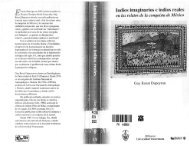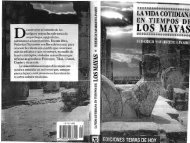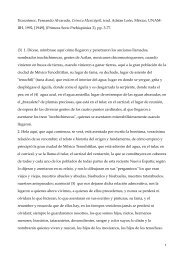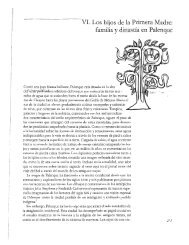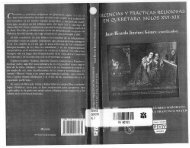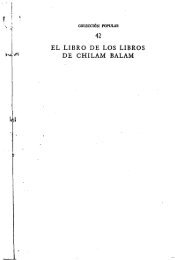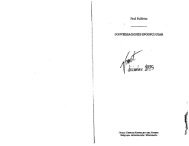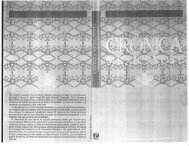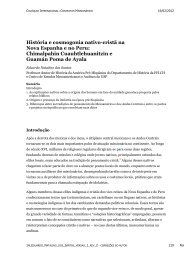1 - Histomesoamericana
1 - Histomesoamericana
1 - Histomesoamericana
Create successful ePaper yourself
Turn your PDF publications into a flip-book with our unique Google optimized e-Paper software.
THE SEVENTH CENTURY<br />
•••• LtZ ^Bg> <br />
From 692 to 751, then the<br />
East priest Bi Ton arrived, the Uaxac Ahau* 8 Anau » 6 ^h<br />
Uac Ahau<br />
6 A* 1311 1 711 )'<br />
(Can Ahau)* (4 Ahau)(731),<br />
Caa Ahau 2 Ahau (751).<br />
Kuchc i is Then arrived<br />
Chac Na Bi Ton* The East priest Bi Ton,<br />
(note continued from preceding page)<br />
begin with 8 Ahau rather than 6 Ahau but otherwise agree with the Xiu. The<br />
beginning date is thus the end of katun 8 Ahau on 9.13.0.0.0 8 Ahau 8 Uo,<br />
March 18, 692.<br />
11. The count now repeats.<br />
13. 4 Ahau has been omitted.<br />
16. Chac Na Bi Ton: the East priest (Chac) and chief of the Toltec Xiu. The<br />
prefix Na 'mother' commonly introduces the matronymic, in this case Bi 'roll',<br />
and the patronymic comes last: Ton 'lame'. Barrera 1948: 59 and Brinton 1882:<br />
144 consider this a place-name.<br />
The place-names of Yucatan are difficult to identify and often difficult to locate<br />
(see Roys 1935). Frequently they are introduced by the locative ti 'at', and the<br />
names of many of the smaller towns follow this with Ix 'little'. A few towns have<br />
monosyllabic names; more commonly the name is inflected or compounded, and<br />
names of four or more elements are not unknown (ti Ix Peton Cah, ti Ix Kil Itzam<br />
Pech). Numeral prefixes of unknown significance occur occasionally: Hun Uc Ma,<br />
Cabil Neb A, Ox Cum, Can Uat Horn, Ho Tzuc Chakan, Uuc y Ab Nal, Uaxac<br />
Tun, Bolon Ch'och', Lahun Chab Le, and Ox Lahun Zuyua. Numbers above 13 do<br />
not seem to occur. Otherwise, since there appear to have been eighteen provinces<br />
(see note 777), I would be tempted to guess that they were numbered in relation<br />
to the uinals. The numeral prefix is invariant over time for any one town.<br />
Classificatory elements are common in place-names: A or Ha 'water', Cab or<br />
Luum 'lands', Hoi Tun 'water hole', Tun 'rock', Cah 'town', Ch'een 'well', Puc<br />
'hill', and Tz'onot 'cenote'. Animal and plant names are frequent descriptive<br />
elements: snail, deer, turkey, iguana, alligator, puma, squirrel, bat, rabbit, dove,<br />
and skunk in the first category, gourdroot, balche, guano palm, caoba, custard<br />
apple, banana, chile, nance, corn, and ceiba in the second. Construction features<br />
occur occasionally: mounds, walls, ovens, and plazas. Color names with directional<br />
associations are frequent. There is a surprising dearth of Náhuatl placenames.<br />
I have found only five: Tizimin [Tzimentian], Mayapan, Yucatan \Yucatlan),<br />
Valladolid [Zaciapan], and Zuyua.<br />
The interpretation of personal names presents several difficulties (Roys 1940).<br />
While it seems likely that calendrical names were used even after the conquest,<br />
they are extremely rare. Examples are 7 Eb and 5 Xóchitl. Numeral elements are<br />
sometimes prefixed to surnames without any accompanying day name, as in 8 Ol<br />
Kauil, 11 Ch'ab Tan, or 7 Sat Ay. I believe these to be priestly titles. Occasionally<br />
a numeral appears to be used as a surname, as in Lahun Chan, Cab Bech', or Hun<br />
Pic. The typical naming system is binomial, and most commonly both names are<br />
monosyllabic, the first being a matronym and the second a patronym, as in Yax<br />
Cutz, Can UI, Kak Mo, or Can Ek. Often the matronym is preceded by Na—Na<br />
Pot Xiu, Na Ahau Pech, or Na Puc Tun—but this appears to be optional. Sometimes<br />
the name is preceded by Ah, as in Ah Muzen Cab or Ah Kin Chil, implying<br />
priesthood or a collective: the man and his family. Women's names may very<br />
occasionally be identified by the prefix Ix, as in Ix Tab or Ix Kalem, but I believe that<br />
this element is far more commonly the simple conjunction 'and'. Both Roys and<br />
Barrera have in my opinion provided us with an entirely excessive list of goddesses.<br />
Very commonly either surname may take the suffix -il or -VI, an abstractive,<br />
again with collective meaning, but this is also optional: Chac Hub, Chac Hubil or<br />
Ul Ahau, Ulil Ahau. Additional elements may precede or follow the name, apparently<br />
for differentiating people of similar names. These may be prefix titles, such<br />
(note continued on following page)



